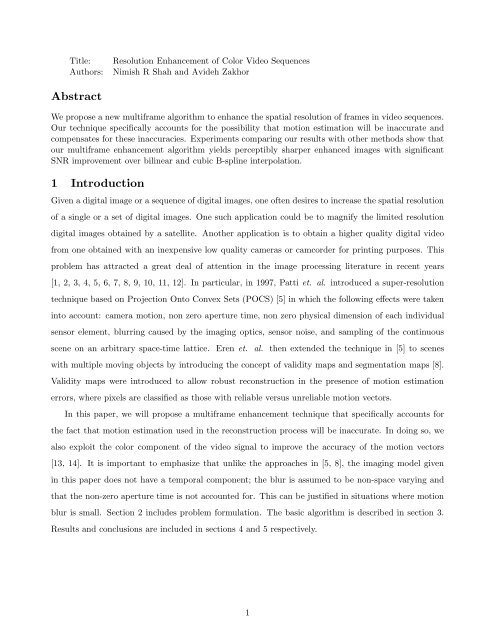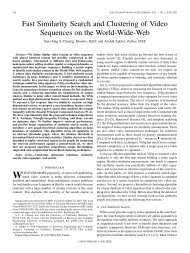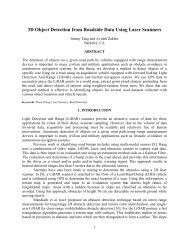Resolution Enhancement of Color Video Sequences
Resolution Enhancement of Color Video Sequences
Resolution Enhancement of Color Video Sequences
You also want an ePaper? Increase the reach of your titles
YUMPU automatically turns print PDFs into web optimized ePapers that Google loves.
Title:<br />
Authors:<br />
<strong>Resolution</strong> <strong>Enhancement</strong> <strong>of</strong> <strong>Color</strong> <strong>Video</strong> <strong>Sequences</strong><br />
Nimish R Shah and Avideh Zakhor<br />
Abstract<br />
We propose a new multiframe algorithm to enhance the spatial resolution <strong>of</strong> frames in video sequences.<br />
Our technique specifically accounts for the possibility that motion estimation will be inaccurate and<br />
compensates for these inaccuracies. Experiments comparing our results with other methods show that<br />
our multiframe enhancement algorithm yields perceptibly sharper enhanced images with significant<br />
SNR improvement over bilinear and cubic B-spline interpolation.<br />
1 Introduction<br />
Given a digital image or a sequence <strong>of</strong> digital images, one <strong>of</strong>ten desires to increase the spatial resolution<br />
<strong>of</strong> a single or a set <strong>of</strong> digital images. One such application could be to magnify the limited resolution<br />
digital images obtained by a satellite. Another application is to obtain a higher quality digital video<br />
from one obtained with an inexpensive low quality cameras or camcorder for printing purposes. This<br />
problem has attracted a great deal <strong>of</strong> attention in the image processing literature in recent years<br />
[1, 2, 3, 4, 5, 6, 7, 8, 9, 10, 11, 12]. In particular, in 1997, Patti et. al. introduced a super-resolution<br />
technique based on Projection Onto Convex Sets (POCS) [5] in which the following effects were taken<br />
into account: camera motion, non zero aperture time, non zero physical dimension <strong>of</strong> each individual<br />
sensor element, blurring caused by the imaging optics, sensor noise, and sampling <strong>of</strong> the continuous<br />
scene on an arbitrary space-time lattice. Eren et. al. then extended the technique in [5] to scenes<br />
with multiple moving objects by introducing the concept <strong>of</strong> validity maps and segmentation maps [8].<br />
Validity maps were introduced to allow robust reconstruction in the presence <strong>of</strong> motion estimation<br />
errors, where pixels are classified as those with reliable versus unreliable motion vectors.<br />
In this paper, we will propose a multiframe enhancement technique that specifically accounts for<br />
the fact that motion estimation used in the reconstruction process will be inaccurate. In doing so, we<br />
also exploit the color component <strong>of</strong> the video signal to improve the accuracy <strong>of</strong> the motion vectors<br />
[13, 14]. It is important to emphasize that unlike the approaches in [5, 8], the imaging model given<br />
in this paper does not have a temporal component; the blur is assumed to be non-space varying and<br />
that the non-zero aperture time is not accounted for. This can be justified in situations where motion<br />
blur is small. Section 2 includes problem formulation. The basic algorithm is described in section 3.<br />
Results and conclusions are included in sections 4 and 5 respectively.<br />
1
2 Problem Statement<br />
Let f(x,y,t) denote a time-varying continuous-space, continuous-time scene projected onto a twodimensional<br />
image plane. Assume that the region <strong>of</strong> interest <strong>of</strong> f(x,y,t) is 0 ≤ x ≤ N 2 ∆,0 ≤ y ≤ N 1 ∆.<br />
Then we can let l (k)<br />
i,j for 0 ≤ k ≤ K − 1,0 ≤ i ≤ N 1 − 1,0 ≤ j ≤ N 2 − 1 denote the (N 1 × N 2 )-pixel,<br />
discrete-space, discrete-time frames in the corresponding digital video sequence <strong>of</strong> length K. l (k)<br />
i,j<br />
denotes the pixel element at the i th row and j th column <strong>of</strong> the k th frame. The relationship between<br />
f(x,y,t) and l (k)<br />
i,j<br />
is given by<br />
l (k)<br />
i,j = ∫ (k+1)T<br />
kT<br />
∫ (i+1)∆ ∫ (j+1)∆<br />
i∆<br />
j∆<br />
f(x,y,t) dx dy dt, i = 0,... ,N 1 − 1, j = 0,... ,N 2 − 1, (1)<br />
where T is the exposure time for obtaining each digital frame. The problem we solve is to use M con-<br />
M−1<br />
(k−<br />
secutive original (N 1 ×N 2 ) pixel video frames {l 2 ) ,... ,l (k) M−1<br />
(k+<br />
,...,l 2 ) } to obtain the sequence<br />
<strong>of</strong> (N 1 × N 2 )-pixel frames {l (k) } to obtain a (qN 1 × qN 2 )-pixel frames h (k) . Without loss <strong>of</strong> generality,<br />
we will present our methods with a value <strong>of</strong> M = 5.<br />
3 <strong>Enhancement</strong> Algorithm<br />
The overall system diagram for the proposed multiframe enhancement algorithm is shown in Figure 1.<br />
The first block in the diagram, labeled “Motion Estimation”, takes the set <strong>of</strong> low resolution intensity<br />
frames as input, with the central frame (Frame #k) as the reference frame, and outputs a set <strong>of</strong><br />
motion estimates for each frame relative to the reference frame. The next block in the diagram, labeled<br />
“Iterative Algorithm”, takes the low resolution intensity frames along with the motion estimates as<br />
input to form an initial estimate <strong>of</strong> the high resolution frame. Then, it takes this initial estimate, along<br />
with the low resolution intensity frames and motion estimates, and applies an iterative algorithm to<br />
converge upon the final enhanced high resolution frame estimate. This section describes each <strong>of</strong> these<br />
procedures in more detail.<br />
3.1 Modified Block Matching Algorithm(MBMA)<br />
Our approach is to match each low resolution frame l (i) ,i ∈ {k − 2,k − 1,k + 1,k + 2} relative to the<br />
reference frame l (k) using the traditional block matching algorithm. There are two novelties to our<br />
motion estimation technique. First, we find a set <strong>of</strong> candidate motion estimates instead <strong>of</strong> a single<br />
motion vector for each pixel <strong>of</strong> the match frame relative to the reference frame. Second, we use both<br />
the luminance and chrominance values to compute the dense field <strong>of</strong> subpixel accuracy motion vectors.<br />
2
3.1.1 Candidate Set <strong>of</strong> Motion Vectors<br />
Our motion estimation algorithm is based on the fact that the true motion vector may have a higher<br />
MSE than other false motion estimates. We have empirically found that the true motion estimate<br />
usually has an MSE close to the “best” or lowest value. Hence, instead <strong>of</strong> simply accepting the possibly<br />
false minimum MSE motion vector as our estimate, we save several candidate motion estimates for each<br />
pixel along with the corresponding MSE’s. These candidates consist <strong>of</strong> the estimate with smallest MSE<br />
along with all the estimates which have an error less than a small multiple τ <strong>of</strong> the minimum MSE.<br />
Using this procedure, for each pixel in the match frame we get a small set <strong>of</strong> possible motion vectors,<br />
ranked by the corresponding MSE, relative to the reference frame. We refer to these set <strong>of</strong> motion<br />
vectors as { ˆm i→k } k+2<br />
i=k−2 .<br />
There are two motivations behind using a candidate set <strong>of</strong> motion vectors rather than a single<br />
motion vector per pixel. First, as we will see later, one motion vector per pixel results in too many<br />
“holes” in the initial high resolution estimate, which in turn causes problems during the iterations<br />
<strong>of</strong> our reconstruction algorithm. Second, the imperfections in traditional BMA sometimes result in<br />
inaccuracies when choosing one motion vector per pixel. An example <strong>of</strong> the lowest MSE leading to<br />
an incorrect motion estimate is shown in Figure 2. Here we have an original high resolution image<br />
consisting <strong>of</strong> an object with a diagonal edge. We also show the resulting low resolution images after<br />
applying a 2 ×2 uniform blurring function to shifted versions <strong>of</strong> the high resolution image. We observe<br />
that the low resolution images l 2 ,l 3 and l 4 are identical despite the fact they correspond to different<br />
shifts relative to the single high resolution image.<br />
3.1.2 Chrominance Components to Increase Accuracy<br />
Another difference between our motion estimation and traditional techniques is our use <strong>of</strong> color [13, 14].<br />
The standard BMA is usually used only on the intensity or luminance component <strong>of</strong> the video signal.<br />
However, since we wish to obtain a high degree <strong>of</strong> accuracy in our motion estimates and because we<br />
will apply our method to color video sequences, our modified block matching algorithm uses the color<br />
components <strong>of</strong> the video signal to aid in motion estimation. In particular, we use luma and chroma<br />
components to arrive at one motion vector for all components based on a technique described at [14].<br />
Harasaki and Zakhor [14] have shown that motion estimation using color components can significantly<br />
reduce motion estimation errors. Our experiments on sequences with known motion showed a 20%<br />
improvement in the number <strong>of</strong> correct motion estimates when using color components in the motion<br />
estimation as compared with luminance only motion estimation. This process adds some computational<br />
complexity to the algorithm but this cost is justified by the increased accuracy achieved.<br />
3
3.2 Iterative <strong>Enhancement</strong><br />
After performing motion estimation to find the correspondences between the set <strong>of</strong> low resolution<br />
frames, we combine the available information to generate an initial high resolution frame estimate and<br />
then iteratively refine this estimate.<br />
3.2.1 Initial High <strong>Resolution</strong> Estimate<br />
For the initial high resolution frame estimate, we combine the low resolution frames using the motion<br />
estimates { ˆm i→k } k+2<br />
i=k−2<br />
from section 3.1.1. The combination method maps all the intensity values from<br />
the set <strong>of</strong> low resolution frames onto a high resolution frame grid using the sets <strong>of</strong> subpixel accuracy<br />
candidate motion vectors. So, the pixels <strong>of</strong> the reference low resolution frame occupy a regularly spaced<br />
subset <strong>of</strong> the high resolution grid. For the remaining low resolution frames, we have subpixel accuracy<br />
motion estimates which enable us to map their pixels to the finer high resolution grid. Since, we<br />
have several frames and multiple motion vectors per pixel, this mapping process will yield some high<br />
resolution pixels with multiple conflicting intensity values landing on them. Since the high resolution<br />
grid is finer than the low resolution grid, it is also possible that some high resolution grid points will<br />
have no low resolution intensity values placed on them. These points are referred to as holes. The<br />
possible situations that can arise are depicted pictorially in Figure 3.<br />
In the case <strong>of</strong> multiple low resolution intensities vying for a single high resolution pixel location,<br />
we choose the intensity and corresponding motion vector <strong>of</strong> the low resolution pixel which had the<br />
lowest MSE during the MBMA algorithm. In the case <strong>of</strong> holes, although no low resolution intensity<br />
points map to the holes, it is still desirable to have a good initial estimate for these pixels before we<br />
start the iterative enhancement. For this reason, we apply an interpolation technique such as nearest<br />
neighbor to estimate the holes based on surrounding filled grid points. The estimates in the initial<br />
high resolution frame will be modified by the iterative algorithm, so high accuracy at this stage is not<br />
required.<br />
3.2.2 Iterative Algorithm<br />
Our iterative stage is based on the Landweber algorithm. For ease <strong>of</strong> summarizing the general scheme,<br />
we consider the case <strong>of</strong> estimating a high resolution frame from only two low resolution frames; the<br />
case with a larger set <strong>of</strong> low resolution frames is a straightforward extension. Initially, we desire a good<br />
estimate <strong>of</strong> the original high resolution frame h from the corresponding set <strong>of</strong> low resolution frames<br />
l (1) and l (2) , which are available to us. At step n − 1 <strong>of</strong> the iteration, we have a high resolution frame<br />
estimate ĥn−1. For step n <strong>of</strong> the iteration, we desire the estimate ĥn to be a better estimate than<br />
ĥ n−1 <strong>of</strong> the original high resolution frame h which is, <strong>of</strong> course, unknown. The original low resolution<br />
4
frames, however, are known and can be used to yield information about h. The approach we take is to<br />
use the motion estimate information to simulate the imaging <strong>of</strong> low resolution frames ˆl (1) and ˆl (2) from<br />
ĥ n−1 . We then compare and determine the error between the simulated low resolution frames ˆl (1) ,<br />
and the original low resolution frames l (1) ,l (2) . We use this computed error in the iteration step to<br />
modify ĥn−1, yielding a better estimate ĥn. Successive iterations allow us to converge on a final high<br />
resolution estimate for the original high resolution frame h. The precise algorithm for this iterative<br />
technique is given below.<br />
Algorithm (Iterative <strong>Enhancement</strong>): Determine a high resolution frame estimate for frame h (k) .<br />
1. Using the method outlined in Section 3.2.1, determine an initial high resolution frame estimate<br />
ĥ (k)<br />
0 and a consistent set <strong>of</strong> motion vectors {m i→k } k+2<br />
i=k−2<br />
from the set <strong>of</strong> low resolution frames<br />
{l (i) } k+2<br />
i=k−2 and the initial motion estimates { ˆm i→k} k+2<br />
i=k−2 .<br />
2. Set the iteration step counter to s = 0, so that ĥ(k) s<br />
in Step 1.<br />
ˆl<br />
(2)<br />
is equal to the initial frame estimate determined<br />
3. Using the high resolution frame estimate ĥ(k) s , apply the imaging process to it using the motion<br />
estimates {m i→k } k+2<br />
(i)<br />
i=k−2<br />
to obtain a sequence <strong>of</strong> simulated low resolution frames {ˆl s } k+2<br />
i=k−2 .<br />
4. Compare the simulated and original low resolution frames, {ˆl s (i) } k+2<br />
i=k−2<br />
and {l(i) s } k+2<br />
i=k−2 , respectively,<br />
to determine the errors in the pixels <strong>of</strong> the high resolution frame estimate ĥ(k)<br />
5. Use the errors determined in Step 4 and the motion vectors {m i→k } k+2<br />
i=k−2<br />
to adjust the high<br />
resolution estimate ĥ(k) s using Landweber’s iterative algorithm to yield a new high resolution<br />
frame estimate ĥ(k) s+1 .<br />
6. Increment the iteration step: s ← s + 1.<br />
7. Repeat Steps 3 to 6 until either the error calculated in Step 4 is less than some desired value or<br />
until a desired number <strong>of</strong> iterations have been performed.<br />
4 Results<br />
s .<br />
We shall now examine some experimental results using the methods described above for Foreman and<br />
Mobile Calendar sequences. For both sequences, we chose τ = 10% for all frames, M = 5, and used<br />
a 2 × 2 uniform support blurring function to obtain a sequence <strong>of</strong> low resolution frarmes. The first<br />
test video sequence, entitled Foreman, consists <strong>of</strong> a camera panning through a scene <strong>of</strong> man’s upper<br />
body in the foreground with a building in the background. The original high resolution frames each<br />
consist <strong>of</strong> one 176 × 144 pixel luminance component and two 88 × 72 pixel chrominance components.<br />
Frame #0, Frame #10, Frame #15 and Frame #25 <strong>of</strong> the low resolution sequence are shown in<br />
5
Figure 4. We applied our multiframe algorithm to the first 25 frames <strong>of</strong> the low resolution Foreman<br />
sequence. For comparison, we also applied the single frame techniques <strong>of</strong> bilinear interpolation and<br />
cubic B-spline interpolation, as well as a multiframe method using traditional BMA for the motion<br />
estimation. Figure 5 shows the original high resolution Frame #0 as well as the high resolution estimate<br />
for Frame #0 obtained by using the different methods. We notice that the single frame techniques look<br />
more blurred than the multiframe result. In particular, the multiframe estimate contains much sharper<br />
edges than either <strong>of</strong> the other two approaches. Note that Frame #0 was estimated from frames -2, -1,<br />
+1, and +2 and that frame #0 was not the first frame <strong>of</strong> the video sequence under consideration.<br />
To perform a more quantitative comparison, we computed the signal-to-noise ratio(SNR) for the<br />
various methods, including a multiframe approach using simple BMA instead <strong>of</strong> the novel approach<br />
proposed in this paper. The results are shown in Figure 6 and Table 5. We observe that our proposed<br />
multiframe method performs better than bilinear interpolation by an average <strong>of</strong> 3.5dB, better<br />
than cubic B-spline interpolation by an average <strong>of</strong> 2.5dB and better than a multiframe method using<br />
traditional BMA by an average <strong>of</strong> almost 2.0dB.<br />
The multiframe algorithm performs significantly better than the single frame methods for all the<br />
frames in the sequence, with greater performance differential for some parts <strong>of</strong> the sequence than others.<br />
Figure 6 reveals that for the first 10 frames the multiframe method is at least 3.0dB better than cubic<br />
B-spline interpolation and at least 4.0dB better than bilinear interpolation. In some regions, however,<br />
such as in the vicinity <strong>of</strong> Frame #10, the improvement is not as dramatic, yielding only 1.0dB <strong>of</strong><br />
improvement. Direct observation <strong>of</strong> the video sequence reveals that the video frames corresponding to<br />
the areas <strong>of</strong> less significant improvement contain very little motion between frames.<br />
The second video sequence, entitled Mobile Calendar, consists <strong>of</strong> nontrivial motions among several<br />
objects possessing fine detail and significant color components. In the sequence, a wall calendar moves<br />
with 3-D translational motion(i.e., translational motion in the image plane as well as a component<br />
perpendicular to the camera), a toy train moves with roughly translational motion and the train<br />
6
pushes a ball which undergoes rotational motion. The original high resolution frames each consist <strong>of</strong><br />
one 400 × 320 pixel luminance component and two 200 × 160 pixel chrominance components. Four<br />
low resolution frames are shown in Figure 7. We followed the same procedure as with the Foreman<br />
sequence to generate a sequence <strong>of</strong> high resolution estimates. The results for Frame #0 are shown in<br />
Figure 8. Once again, note that frame #0 was estimated from frames -2, -1, +1, and +2 and that frame<br />
#0 was not the first frame <strong>of</strong> the video sequence under consideration. We observe that the multiframe<br />
method is capable <strong>of</strong> reproducing an estimate that is comparable to the original high resolution frame.<br />
The details in the multiframe estimate are much sharper than those in either single frame interpolation<br />
method. The quantitative results support the perceived improvement in quality. Table 5 shows the<br />
average SNR for the various methods over the entire sequence. The multiframe approach performs<br />
about 1.1dB better than bilinear interpolation, about 1.6dB better than cubic B-spline interpolation<br />
and about 0.86dB better than multiframe using traditional BMA. Figure 9 shows the SNR plot. We<br />
observe that the proposed method outperforms the others throughout the sequence.<br />
5 Conclusions<br />
We have proposed an approach for enhancing the spatial resolution <strong>of</strong> a color video sequence by using<br />
multiple frames to obtain each enhanced resolution frame. The results presented in Section 4 indicate<br />
that this multiframe approach significantly outperforms standard single frame approaches in both SNR<br />
and perceived visual quality. This is in spite <strong>of</strong> the fact that there is no explicit model taken into account<br />
for the motion blur [5]. It is important to emphasize that the desired expansion factor determines the<br />
accuracy with which the motion vectors need to be determined. For example, a 3X magnification factor<br />
would have required motion vector estimation with resolution <strong>of</strong> 1/3 pixels. Convergence properties <strong>of</strong><br />
the algorithm are demonstrated in [15].<br />
References<br />
[1] S. P. Kim and W. Y. Su, “Recursive high resolution reconstruction <strong>of</strong> blurred multiframe images,”<br />
7








